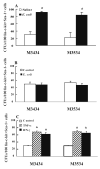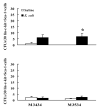The lineage-c-Kit+Sca-1+ cell response to Escherichia coli bacteremia in Balb/c mice
- PMID: 18483422
- PMCID: PMC2731662
- DOI: 10.1634/stemcells.2007-1027
The lineage-c-Kit+Sca-1+ cell response to Escherichia coli bacteremia in Balb/c mice
Abstract
During bacterial infection, the bone marrow hematopoietic activity shifts toward granulocyte production, which is critical for host defenses. Along with this enhancement of granulopoiesis, the bone marrow also increases its release of hematopoietic precursors. At the present time, little is known about the commitment of hematopoietic precursor cells, including hematopoietic stem cells and progenitors, in this response. To investigate the hematopoietic precursor cell response to bacterial infection, bacteremia was established in Balb/c mice by i.v. injection of Escherichia coli. Bacteremia caused a 10-fold increase in the number of lineage (lin)-c-kit+Sca-1+ cells in the bone marrow. This dramatic expansion of the lin-c-kit+Sca-1+ cell pool resulted from both increased mitosis of these cells and inversion from lin-c-kit+Sca-1- cell phenotype. Lipopolysaccharide, tumor necrosis factor-alpha, and interleukin-6 were potent factors capable of mediating phenotypic inversion of lin-c-kit+Sca-1- cells. Cells in the expanded lin-c-kit+Sca-1+ cell pool contained more colony-forming unit-granulocyte/macrophage. Mobilization of lin-c-kit+Sca-1+ cells into the circulation was significantly enhanced following bacteremia. These results demonstrate that the lin-c-kit+Sca-1+ cell population in the bone marrow constitutes a key component of the host defense response to bacteremia. Functional modifications of these primitive hematopoietic precursors are critical for enhancing granulocyte production following bacterial infection.
Figures







References
-
- Kondo M, Wagers AJ, Manz MG, et al. Biology of hematopoietic stem cells and progenitors: implications for clinical application. Annu Rev Immunol. 2003;21:759–806. - PubMed
-
- Akala OO, Clarke MF. Hematopoietic stem cell self-renewal. Curr Opin Genet Dev. 2006;16:496–501. - PubMed
-
- Hartmann DW, Entringer MA, Robinson WA, et al. Regulation of granulopoiesis and distribution of granulocytes in early phase of bacterial infection. J Cell Physiol. 1981;109:17–24. - PubMed
-
- Barthlen W, Zanti N, Pfeffer K, et al. Impact of experimental peritonitis on bone marrow cell function. Surgery. 1999;126:41–47. - PubMed
Publication types
MeSH terms
Substances
Grants and funding
LinkOut - more resources
Full Text Sources
Other Literature Sources
Medical
Research Materials

